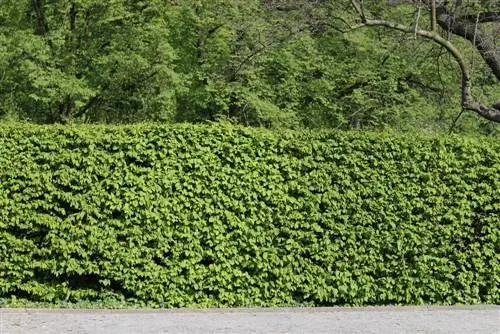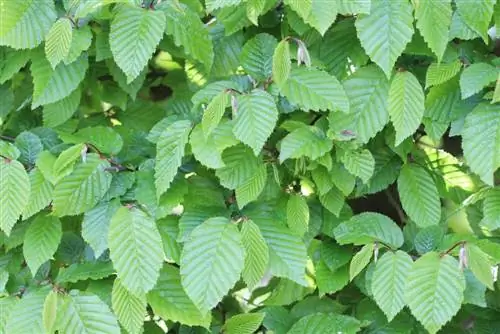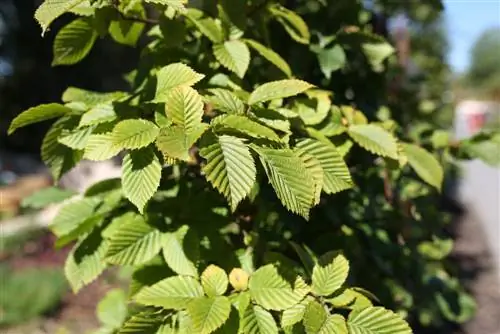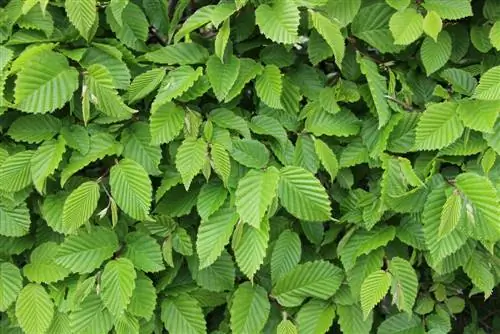- Author admin [email protected].
- Public 2023-12-17 03:39.
- Last modified 2025-06-01 06:48.
Beech trees are a familiar sight in the forest as native deciduous trees. Their rapid growth, opaque foliage and robust pruning tolerance make these long-lasting trees a green bulwark as a hedge against prying eyes, noise and dirt. In the natural garden, wild animals find a protected place to retreat and the nutritious beechnuts provide a valuable source of food. In order for a beech hedge to meet expectations, pruning is the linchpin of the care program. These instructions explain in detail and in a practical manner when and how to properly trim a beech hedge.
The best time
Beech trees are constantly striving to develop into a majestic tree, even as hedge plants. In order to convince the trees of an opaque and compact life as shrubs, they should be cut regularly right from the start. Don't wait until they reach the desired height. Because then beech trees strive tirelessly towards the sky and neglect growth in width with dense branching from the base. From a growth height of 80 to 100 cm, it is recommended to prune the tree at least once a year. With a view to annual growth of 30 to 50 cm, the scissors can also be used several times to ensure that the well-groomed appearance is maintained.
The species-specific growth of a beech is not the only criterion for the best time to prune. Local weather conditions and the requirements of the Federal Nature Conservation Act are also taken into account. We have summarized all the requirements for you below so that you can cut your beech hedge at the perfect time:
- One-time topiary: end of June
- Twice topiary: end of May and end of August
- Only in dry and overcast weather without direct sunlight
- Thinning or rejuvenation cut: January/February on a frost-free day
- Pruning: immediately after planting or in the fall of the planting year
Between March 1st and September 30th, only light pruning of hedge plants may be carried out to protect breeding birds. In this respect, the Federal Nature Conservation Act does not impose any restrictions on the professional pruning of a beech hedge, since the focus is on harmonious shaping in the midst of the growing season. Deep interventions in growth, such as thinning out dead wood or radical rejuvenation pruning, should always take place during the winter sap dormancy and comply with legal regulations.
Preparatory work
The larger a beech hedge, the less it is possible to create an accurate, uniform look freehand. Therefore, when making topiary cuts, do not rely on your sense of proportion, but rather use orientation aids. Furthermore, safety must not be neglected while working. The following preparatory work is recommended:
- The beech hedge investigates breeding grounds for wild animals
- If necessary, postpone the appointment until birds or other small animals have completed their breeding business
- Drive wooden posts into the ground at both ends of the beech hedge
- Tighten cords at the level of the desired growth height
- Put on safety glasses, gloves and long-sleeved clothing
If you are using manual hedge trimmers, sharpen the blades to create smooth cutting surfaces. Careful disinfection with alcohol is essential for all cutting tools so that no pathogens or pests can spread through the beech hedge via contaminated cutting surfaces.
Tip:
Spray a beech hedge with water before pruning. This reduces stress on the plants, makes cutting easier, limits dust and keeps the scissors sharp longer.
Tips for the perfect shape

For a beech hedge to develop he althily and with dense leaves, there is not much room for playful design forms. Leaves can only sprout where there is sufficiently bright light for photosynthesis. The trapezoid shape is perfect for fulfilling this premise. A wide base gradually tapers into a narrower crown. Thanks to sloping surfaces on the wide and narrow sides, enough light reaches the interior of your beech hedge, which effectively prevents baldness.
If you don't like the trapezoid shape, consider a rectangle as an alternative. However, a shape with a narrow base and wide top is not suitable for vigorous growth and dense foliage. If you give your beech hedge this contour, it will shade itself, whereupon the shoots in the lower part will shed their leaves and lose considerable growth power.
Instructions for summer topiary
Once the preparatory work has been completed, give your beech hedge the desired shape with the following cut:
- Move the hedge trimmer from bottom to top
- In the first step, cut the front and back surfaces
- Then shorten the narrower sides
- In the last step, cut the top smoothly along the guide
Please do not leave the clippings on the top of the beech hedge. Branches left lying down cast shadows and hinder fresh growth. Rake the clippings together on the ground and ideally shred them in a shredder to dispose of them in the compost or to use as mulch.
Tip:
When cutting a beech hedge with the electric hedge trimmer, the power cable is forgotten in the heat of the moment. To avoid accidentally cutting the cable, simply place it backwards over your shoulder.
Thinning out in winter - this is how it works
From the fourth or fifth year onwards, dead wood can develop within a beech hedge, shading and hindering vital branches. Weak or too densely placed shoots can also affect the vitality of the bushes. The leafless winter period is therefore a good time to thin out the hedge. How to do it right:
- Cut dead shoots above the ground
- Cut off weak, stunted side shoots from the main shoot
- Remove the older branches from branches that are too close together
- Short weak ground shoots by half or cut to a string
Special shrub shears are helpful in order to access the relevant shoots in a densely branched, broadly bushy beech hedge. With the rotating cutting head and handles that are further away than with conventional pruning shears, it is easily possible to accurately grasp the shoot with the blades and cut it off.
Instructions for plant cutting
Planting a beech hedge from root products significantly reduces costs. Since root mass was lost during removal from the tree nursery, a plant cut restores the balance. Cheap container plants usually only have 2 to 3 main shoots, which is not ideal starting conditions. So that young beech trees grow well as root or container plants and branch lushly right from the start, planting is advisable.

Cut off all unbranched shoots by a third to a half during the planting year. Ideally, you should place the scissors a few millimeters above a sleeping eye to encourage branching. Sleeping eyes are not always easy to recognize on young shoots. If you run your finger over the bark, you can often feel the leaf nodes as a slight bump.
Instructions for the rejuvenation cut
Without annual pruning, hedge plants become old within 5 to 6 years. The native beech is no exception in this regard. Overly long, bare shoots develop that bend towards the ground, so that the hedge gradually falls apart. If your beech hedge has suffered such a fate, this is no reason to clear it. Every beech tree has the potential to live for 400 years or more. With a radical rejuvenation cut you can awaken your spirits and get your growth going again. This is how it works:
- Inspect the beech hedge for wild animals living in it in January/February
- Cut all branches back to a height of 30 cm
- Cut off dead wood at the base
The beech trees will sprout again from the remaining canes at the beginning of the next growing season. From a height of 80 cm, the recommended rhythm of summer topiary and winter thinning begins. In order not to deprive a natural garden of a complete hedge, you can spread the rejuvenation cut over 2 to 3 stages. These take place every 12 months in late winter.
Wound closure only in exceptional cases
A professional shape and care cut will not leave any major cuts on your beech hedge, as only last year's growth is cut off. If you remove old ground shoots or dead wood in late winter, large wounds can sometimes occur. In earlier years, the concerned gardener resorted to a waterproof and airtight wound closure with the good intention of supporting the healing process.
Modern research results show that sealing cuts on trees is rather detrimental to healing. The self-healing powers of plants are significantly hindered or even completely prevented under the influence of artificial preparations. With their cell-dividing cambium wood along the edges of the wound, the plants strive to overflow the cut surface. Wound closure is therefore largely avoided in modern woody care. Only after a winter cut can the wound edges be lightly coated with breathable tree paste to protect the valuable cell tissue from frost and dryness until it can fulfill its wound healing task in spring.
Proper care after pruning

Every established, well-rooted beech hedge is self-sufficient and requires little further care apart from pruning. The hedge plants are still grateful for a supply of nutrients after a cut. After thinning out in late winter and topiary in summer, fertilize with ripe compost and horn shavings. Spread the organic fertilizer on the root disc, rake it in lightly and water again.
A freshly planted beech hedge has to contend with competition in the form of grass and weeds in the first few years. Therefore, please keep the root disc free by weeding regularly. A mulch layer of leaves, pine bark or conventional bark mulch effectively suppresses weed growth. In later years, the foliage shades the ground so intensively that hardly any other plants can gain a foothold here.
Conclusion
If you cut your beech hedge at a young age, it will transform into an opaque, green wall from the ground to the crown. Even a single grooming cut at the end of June will maintain a well-groomed appearance. Moderate pruning in late May and late August will leave you with a decorative hedge that looks like it's been peeled from scratch if you follow these instructions. The trapezoidal shape guarantees light-flooded plants that cannot go bald. Winter thinning also makes a valuable contribution to a dense foliage and youthful vitality well into old age. A rejuvenation cut in late winter at knee height gets the growth going again on an over-aged, senile beech hedge.

